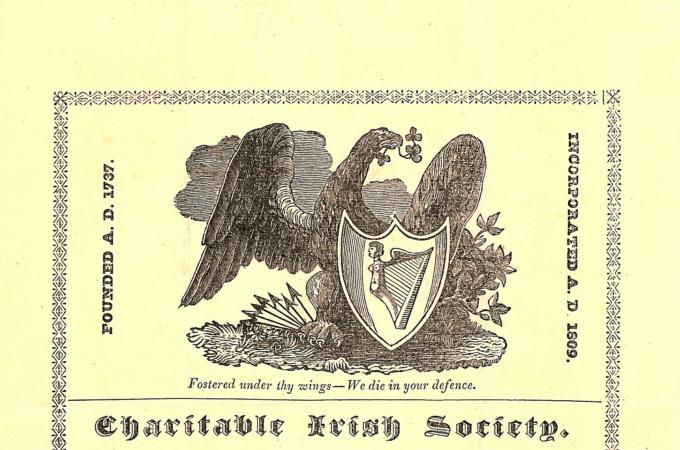The Charitable Irish Society
Every St. Patrick's Day, the Charitable Irish Society holds a dinner to celebrate its work and accomplishments. While we most closely associate Irish immigration, from a historical perspective at least, with the mid-19th Century, the society was actually founded over a century earlier, in 1737, making it the oldest Irish society in the Americas.
The society, which is still in existence today, defines its mission in two parts. First, to cultivate a spirit of unity between the Irish and their descendants, and advocate for the social and moral interests of the Irish people and their heritage. Second, "to alleviate svuffering, and to aid such of its members or other worthy recipients as by the vicissitudes of fortune might be deserving of its charity."
The Society was founded by immigrants from the Ulster region, who were largely Protestant, and had successfully settled in the Boston area. Their objective was to assist those who were newer arrivals to this country, helping them find housing, employment, and providing direct financial assistance when necessary. There are signs which indicate that they contributed to larger charitable projects as well. In 1794, the society made a donation to a school fund which was maintained by Father Francis Matignon of the Church of the Holy Cross "to purchase school books for poor children of Irish extraction." It is worth noting that while the founding members and officers were largely Protestant during its first few decades, no distinction was made between Protestants and Catholics who required assistance.
Much has been made of the roles Fathers Matignon and Jean Cheverus played in unifying the Catholic community in the Boston area. Prior to their arrival, there was frustration among the English-speaking Catholics with the French-speaking priests who served them. Fathers Matignon and Cheverus were able to heal these fissures and raise the reputation of Catholics among all Bostonians. One piece of evidence to this end is the invitations the two priests received to the society's St. Patrick's Day banquet in 1806, and again in 1810, then annually from 1814 onward. In fact, in 1817, Bishop Cheverus was invited to be the main speaker at the event.
Today, 180 years later, the Charitable Irish Society continues its mission, assisting new Irish immigrants who arrive in the United States. To accomplish this, they offer seminars on topics such as housing, employment, finance, law, and other areas to help them adapt to their new surroundings. Since 1996, it has also participated in a program which encourages them to become United States citizens and helps them with the application process.
For those who are interested in learning more, there is currently an exhibition on Irish Immigration at the Massachusetts Historical Society (masshist.org) -- "The Irish Atlantic: A Story of Famine, Migration, and Opportunity." The exhibition covers Irish immigration to Boston from the year 1737, with the founding of the Charitable Irish Society, through the early 20th Century. The exhibit opened on March 10, and will be on display until Sept. 22. It is open to the public Monday through Saturday, from 10am to 4pm, and admission is free.
Additional information about the about the Charitable Irish Society can be found on their website: charitableirishsociety.org.
THOMAS LESTER IS THE ARCHIVIST OF THE ARCHDIOCESE OF BOSTON.



















